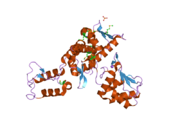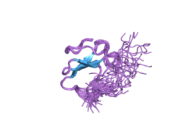Biology:SMURF2
From HandWiki
 Generic protein structure example |
E3 ubiquitin-protein ligase SMURF2 is an enzyme that in humans is encoded by the SMURF2 gene.[1][2]
Interactions
SMURF2 has been shown to interact with:
- Mothers against decapentaplegic homolog 1,[1]
- Mothers against decapentaplegic homolog 2,[1][3][4]
- Mothers against decapentaplegic homolog 3,[1][3][4]
- Mothers against decapentaplegic homolog 7,[5][6][7]
- SCYE1,[7]
- SMURF1,[8] and
- Ubiquitin C.[7][9]
References
- ↑ 1.0 1.1 1.2 1.3 "Smurf2 is a ubiquitin E3 ligase mediating proteasome-dependent degradation of Smad2 in transforming growth factor-beta signaling". The Journal of Biological Chemistry 275 (47): 36818–22. Nov 2000. doi:10.1074/jbc.C000580200. PMID 11016919.
- ↑ "Entrez Gene: SMURF2 SMAD specific E3 ubiquitin protein ligase 2". https://www.ncbi.nlm.nih.gov/sites/entrez?Db=gene&Cmd=ShowDetailView&TermToSearch=64750.
- ↑ 3.0 3.1 "TGF-beta induces assembly of a Smad2-Smurf2 ubiquitin ligase complex that targets SnoN for degradation". Nature Cell Biology 3 (6): 587–95. Jun 2001. doi:10.1038/35078562. PMID 11389444.
- ↑ 4.0 4.1 "Pin1 down-regulates transforming growth factor-beta (TGF-beta) signaling by inducing degradation of Smad proteins". The Journal of Biological Chemistry 284 (10): 6109–15. Mar 2009. doi:10.1074/jbc.M804659200. PMID 19122240.
- ↑ "Impaired Smad7-Smurf-mediated negative regulation of TGF-beta signaling in scleroderma fibroblasts". The Journal of Clinical Investigation 113 (2): 253–64. Jan 2004. doi:10.1172/JCI16269. PMID 14722617.
- ↑ "Smad7 binds to Smurf2 to form an E3 ubiquitin ligase that targets the TGF beta receptor for degradation". Molecular Cell 6 (6): 1365–75. Dec 2000. doi:10.1016/s1097-2765(00)00134-9. PMID 11163210.
- ↑ 7.0 7.1 7.2 "AIMP1/p43 downregulates TGF-beta signaling via stabilization of smurf2". Biochemical and Biophysical Research Communications 371 (3): 395–400. Jul 2008. doi:10.1016/j.bbrc.2008.04.099. PMID 18448069.
- ↑ "Smurf2 induces ubiquitin-dependent degradation of Smurf1 to prevent migration of breast cancer cells". The Journal of Biological Chemistry 283 (51): 35660–7. Dec 2008. doi:10.1074/jbc.M710496200. PMID 18927080.
- ↑ "Smurf2 is a TRAF2 binding protein that triggers TNF-R2 ubiquitination and TNF-R2-induced JNK activation". Biochemical and Biophysical Research Communications 374 (4): 752–7. Oct 2008. doi:10.1016/j.bbrc.2008.07.103. PMID 18671942.
- ↑ "Smurf2-Mediated Stabilization of DNA Topoisomerase IIα Controls Genomic Integrity". Cancer Research 77 (16): 4217–4227. Aug 2017. doi:10.1158/0008-5472.CAN-16-2828. PMID 28611047.
Further reading
- "Regulation of Smad degradation and activity by Smurf2, an E3 ubiquitin ligase". Proceedings of the National Academy of Sciences of the United States of America 98 (3): 974–9. Jan 2001. doi:10.1073/pnas.98.3.974. PMID 11158580. Bibcode: 2001PNAS...98..974Z.
- "Smad7 binds to Smurf2 to form an E3 ubiquitin ligase that targets the TGF beta receptor for degradation". Molecular Cell 6 (6): 1365–75. Dec 2000. doi:10.1016/S1097-2765(00)00134-9. PMID 11163210.
- "TGF-beta induces assembly of a Smad2-Smurf2 ubiquitin ligase complex that targets SnoN for degradation". Nature Cell Biology 3 (6): 587–95. Jun 2001. doi:10.1038/35078562. PMID 11389444.
- "The RING-H2 protein RNF11 is overexpressed in breast cancer and is a target of Smurf2 E3 ligase". British Journal of Cancer 89 (8): 1538–44. Oct 2003. doi:10.1038/sj.bjc.6601301. PMID 14562029.
- "Impaired Smad7-Smurf-mediated negative regulation of TGF-beta signaling in scleroderma fibroblasts". The Journal of Clinical Investigation 113 (2): 253–64. Jan 2004. doi:10.1172/JCI16269. PMID 14722617.
- "An RNF11: Smurf2 complex mediates ubiquitination of the AMSH protein". Oncogene 23 (10): 1801–8. Mar 2004. doi:10.1038/sj.onc.1207319. PMID 14755250.
- "Transforming growth factor-beta stimulates p300-dependent RUNX3 acetylation, which inhibits ubiquitination-mediated degradation". The Journal of Biological Chemistry 279 (28): 29409–17. Jul 2004. doi:10.1074/jbc.M313120200. PMID 15138260.
- "Transcriptome characterization elucidates signaling networks that control human ES cell growth and differentiation". Nature Biotechnology 22 (6): 707–16. Jun 2004. doi:10.1038/nbt971. PMID 15146197.
- "Functional proteomics mapping of a human signaling pathway". Genome Research 14 (7): 1324–32. Jul 2004. doi:10.1101/gr.2334104. PMID 15231748.
- "Sequence comparison of human and mouse genes reveals a homologous block structure in the promoter regions". Genome Research 14 (9): 1711–8. Sep 2004. doi:10.1101/gr.2435604. PMID 15342556.
- "Smurf2 up-regulation activates telomere-dependent senescence". Genes & Development 18 (24): 3028–40. Dec 2004. doi:10.1101/gad.1253004. PMID 15574587.
- "High-throughput mapping of a dynamic signaling network in mammalian cells". Science 307 (5715): 1621–5. Mar 2005. doi:10.1126/science.1105776. PMID 15761153. Bibcode: 2005Sci...307.1621B.
- "Transcriptional induction of Smurf2 ubiquitin ligase by TGF-beta". FEBS Letters 579 (12): 2557–63. May 2005. doi:10.1016/j.febslet.2005.03.069. PMID 15862290.
- "Regulation of Smurf2 ubiquitin ligase activity by anchoring the E2 to the HECT domain". Molecular Cell 19 (3): 297–308. Aug 2005. doi:10.1016/j.molcel.2005.06.028. PMID 16061177.
- "An expanded WW domain recognition motif revealed by the interaction between Smad7 and the E3 ubiquitin ligase Smurf2". The Journal of Biological Chemistry 281 (25): 17069–75. Jun 2006. doi:10.1074/jbc.M601493200. PMID 16641086.
- "Autoinhibition of the HECT-type ubiquitin ligase Smurf2 through its C2 domain". Cell 130 (4): 651–62. Aug 2007. doi:10.1016/j.cell.2007.06.050. PMID 17719543.



